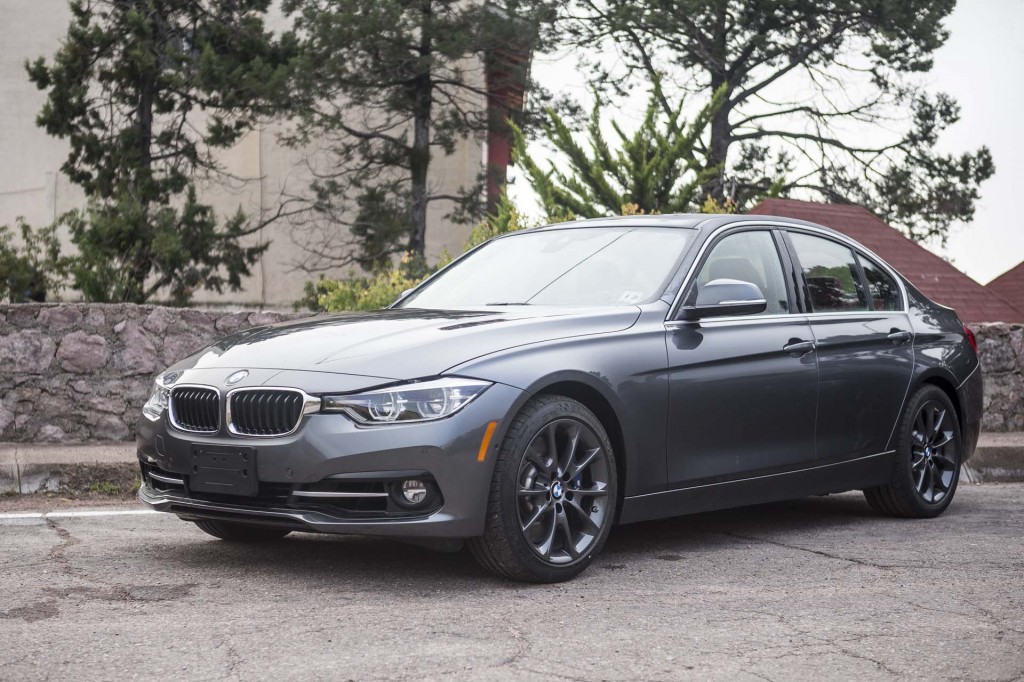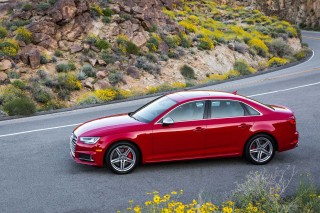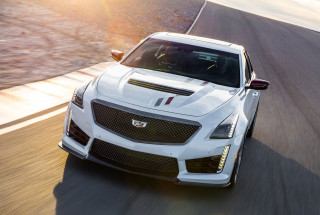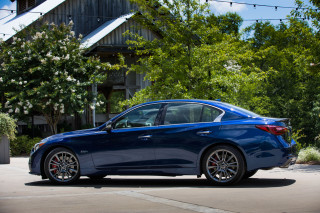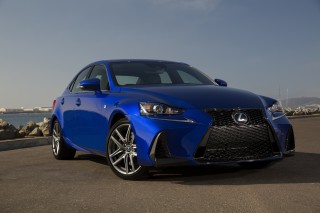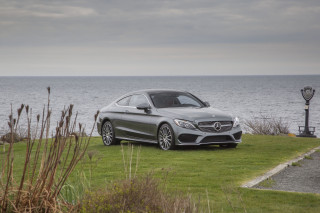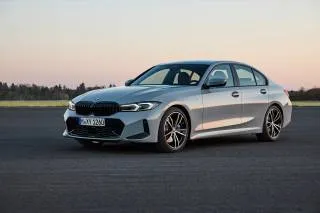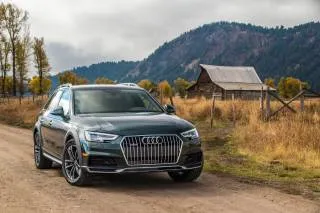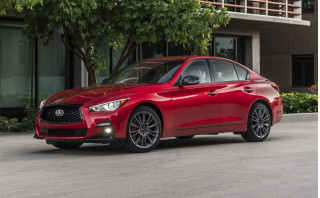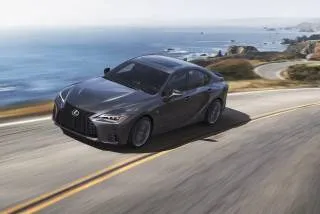Likes
- Classic look
- Wide number of powertrains
- Plenty of body styles (wagon!)
- Great turbo-4 and 8-speed auto
Dislikes
- Gets expensive, almost unnecessarily
- Dated interior
- Spartan base model
- Competitors have caught up, or even passed the 3-Series
Buying tip
features & specs
The 2018 BMW 3-Series makes its strongest case in performance for luxury compact buyers’ attentions.
These days BMW leaves no stone unturned, yet the 2018 BMW 3-Series is still its rock. The automaker seemingly makes a model for every imaginable mood, and the 3er’s starting to feel tired to us.
It earns a respectable 6.7 out of 10 on our overall scale. Its style, tech, and execution are outclassed by competitors from Mercedes and Audi, but BMW can still thrill with its performance possibilities. (Read more about how we rate cars.)
Not much changed for the 2018 3-Series. It’s still offered in a wide array of powertrain and body configurations, including a wagon, sedan, and tall-riding fastback, which BMW calls the 3-Series Gran Turismo. In the past, it’s been possible to shave two doors off the 3-Series, but BMW has cleaved those coupes into a different model range, called the 4-Series, that we cover separately.
A handful of package shuffles and new paint colors await shoppers for 2018, but largely this car hasn’t changed for a couple years. A new version of the 3-Series isn’t far off, which means that this version is fully baked.
If you’re looking for something—anything—with a BMW roundel, you might be tempted by the 320i’s lease price and teaser deals. Pick up a side hustle, we’d say, and opt instead for a 330i and its uprated turbo-4.
From there, a 340i turbo-6 awaits well-heeled shoppers who wouldn’t trust themselves with a M3 (don’t worry, we can’t trust ourselves either).
A diesel-powered 328d wagon is the white whale of the lineup; surely one of the last oil-burning wagons we’ll see for a generation or longer.
While base 2018 BMW 320i sedans start at a reasonable $35,895, including destination, don’t expect to see many on dealer lots at that price. BMW charges more for many conveniences that others throw in for free, including $300 for Apple CarPlay, provided you’ve already sprung for $2,000 in navigation. Yeesh.
2018 BMW 3-Series Styling
The 2018 BMW 3-Series has a classic exterior shape, but its interior is starting to feel aged.
The exterior of the 2018 BMW 3-Series and a standard tuxedo will look good in 10 years. The sedan’s lines are still attractive, helped by its classic profile and rear-wheel-drive tendencies. Its shapely hood and kidney-shaped grille are BMW hallmarks, and help future-proof it against a new generation of the 3-Series that’s surely coming soon.
On our styling matrix, we give the 2018 BMW 3-Series a point over average for its good exterior shape. Like a 10-year-old tuxedo, we’re not sure how the inside will hold up after repeated wear, so we’ll stop short of going any higher than a 6 out of 10. (Read more about how we rate cars.)
There are multiple body styles to consider with the 3-Series, including a wagon and tall-riding sedan. We think most buyers will opt for the four-door sedan, which manages to be expressive without being flashy.
The window line gradually walks up to the trunk, which helps lower the nose and give the 3-Series an aggressive attitude.
Despite not sharing any sheet metal with the sedan, the Gran Turismo is recognizable as a member of the 3-Series family, especially its nose.
Inside, the 3-Series is a mishmash of current features on older bones. The base infotainment screen is perched atop the dash with a bolt-on feel; the smattering of premium materials, including wood trim and brushed aluminum are sandwiched into small spaces; and the infotainment controller can awkwardly float in a sea of gray plastic on base cars.
As with most cars from BMW, spend more and get more, but top-trim 3-Series cars can already run toward $50,000 faster than we’d like.
2018 BMW 3-Series Performance
The turbo-6 in the 340i is loads of fun, but the 330i and its turbo-4 are hugely compelling.
The BMW 3-Series has a well-earned reputation for being a competent performer among compact luxury sedans. This year’s version is no different, albeit with one exception.
We give the 2018 BMW 3-Series a 7 out of 10 for performance with a hat tip for a strong turbo-4 and a very competent 8-speed automatic. (Read more about how we rate cars.)
The BMW 3-Series offers a relatively exhaustive list of powertrain possibilities, so we hope the rest of your day is clear.
Turbo-4
There are four available turbo-4 configurations available in the 2018 BMW 3-Series, including one hybrid option and an increasingly rare turbodiesel.
Base 320i models will be powered by a 2.0-liter turbo-4 that makes 180 horsepower and 200 pound-feet of torque mated to an 8-speed automatic or 6-speed manual. That kind of power is adequate for the 320i, which weighs 3,320 pounds, but it’s hardly overwhelming. Broadly speaking, the 320i will be a tease for many interested shoppers who will be attracted to the mid-$30,000s price more so than the engine output. All-wheel drive, which BMW calls “xDrive,” is available on all models, including the 320i, but we’d hesitate to burden the small turbo-4 with the 140 pounds of additional running gear that all-wheel drive requires.
For your long term enjoyment and opinion of your new-car purchase (or lease), we suggest the uprated turbo-4 that’s making the rounds as the corporate standard-bearer for efficiency and performance.
The 2018 BMW 330i is powered by a 2.0-liter turbo-4 that makes 248 hp and 258 lb-ft mated to the same 8-speed automatic or 6-speed manual. The 330i is sharper and more enjoyable to drive, with plenty of highway pull that BMW shoppers are likely looking for. In multiple drives with the same engine across many models, the turbo-4 helped us all but erase wistful memories of the vaunted BMW “straight-6” that was so beloved and recently retired. The new turbo-4 is that good.
A small number of sedans (and perhaps wagons) will sport a 180-hp 2.0-liter turbodiesel under their hoods. It’s the long-legged highway champ of the 3-Series lineup—up to 40 mpg highway, although it’s relatively expensive and exceedingly rare. Like most diesels, we admire the 328d’s strong pull, but its high cost of entry and bad press may not be enough to lure buyers.
The 330e hybrid is the last of the turbo-4s, and perhaps the rarest. It mates the 320i’s 180-hp engine with a 7.6-kwh battery and 87-hp electric motor for a combined output of 246 hp. In very limited drives with the 330e we’ve noted the car’s seamless power delivery, effortlessly mixing engine power with electric drive. We’ve also noticed the car’s prodigious weight: the batteries and electric motor add more than 500 pounds to the car’s weight.
Turbo-6
Available in Gran Turismo and sedan body styles (sorry wagon, no fun for you), the turbo-6 behind the 340i badges is a compelling alternative to the Mercedes-AMG C43 and Audi S4.
The 2018 BMW 340i spins out 320 hp and 330 lb-ft of torque from its 3.0-liter turbo-6, and it’ll do the dash up to 60 mph in less than five seconds. BMW offers the 340i in rear-drive with a manual transmission, both of which are more than Audi and Mercedes can say for their near-performance sedans.
The manual, which is available on gas-powered sedan models (no diesel nor hybrid), feels crisp without being too notchy, and a smooth clutch uptake will be welcome for drivers who’ll expect their 340i athletes to compete in daily stoplight grand prix duty too.
Normally, we’d stop at that, but the automatic is just too good to ignore. A traditional 8-speed automatic fires through shifts in all models and almost telepathically reads our right foot on downshifts. We like the 8-speed and wouldn’t begrudge any buyer for succumbing to its easygoing charms. It’s the only option for GT models.
All-wheel drive is available for the 340i in the sedan, and is standard on GT models.
Handling and steering
The 3-Series’ historically famed je ne sais quoi of good steering can be distilled down to three parts: good weight distribution, adequate power to the rear, and communicative steering. The current 3-Series possesses the first two while largely skipping the third. The tiller on the 3-Series builds weight nicely, but lacks any of the feedback we loved in prior generations. To be sure, the new 3-Series has impressive grip in most configurations, but you would be hard-pressed to know behind the wheel.
A variable sport steering package can be added to most cars that mechanically alters the steering ratio (rather than using electronics to do it) that helps the 3-Series progressively quicken its rack when carving up canyons.
Mostly, the 3-Series rides comfortably and competently, despite its rolling-rock standard run-flat tires.
2018 BMW 3-Series Comfort & Quality
Like a newspaper, the 2018 BMW 3-Series plants the most important stuff up front.
The 2018 BMW 3-Series has a fighting chance to be just as comfortable as its competitors, but it doesn’t go the distance in terms of long-term comfort.
Driver and passenger won’t have much to fuss about, but rear-seat riders and cargo space just can’t measure up in the end. We give it a 6 out of 10. (Read more about how we rate cars.)
We like the adjustable front seats and supportive sport buckets found in 340i models. BMW makes available in nearly every model its adjustable thigh supports that help long-legged drivers like us, which we appreciate.
Long-legged drivers and passengers won’t do much for rear-seat riders, who get 35.1 inches of rear-seat leg room on paper. In reality, the space is smaller than that, and it’s not helped by front seats that are lacking deep scallops to make best use of available space.
BMW’s synthetic leather isn’t bad, but we’re not sure how well it’ll age. Plusher hides or sport seats with contrast stitching look better and feel better on our backsides, but they come at a hefty price.
Most 3-Series will be sedans, which have 17 cubic feet of cargo room and 60/40-split folding rear seats for more storage flexibility. Wagons and 3-Series GT models have 27.5 and 24.6 cubic feet of cargo room, respectively, while the odd 3-Series hybrid’s batteries shave the trunk to just 13 cubes.
2018 BMW 3-Series Safety
Good safety scores for the BMW 3-Series are somewhat ruined by costly add-ons that others aren’t charging extra for.
Good crash test scores are assets for the 2018 BMW 3-Series, but advanced safety tech is expensive.
The BMW 3-Series was named a Top Safety Pick by the IIHS for its top “Good” scores on all crash tests, available active safety systems, and top-performing optional headlights.
Federal testers largely agreed and gave the 3-Series a five-star overall score, despite a four-star score for front-crash safety.
That report card would be good enough for an 8 out of 10, but BMW’s insistence on charging more for what several automakers include as standard is a demerit. It earns a 7 out of 10. (Read more about how we rate cars.)
About those pricey add-ons: Getting to that Top Safety Pick car requires a bundle of $4,000 or more that balloons the bottom line by 10 percent or more.
2018 BMW 3-Series Features
The BMW 3-Series is quick behind the wheel and even quicker to empty shoppers’ wallets.
If anything, the BMW roundel is a good personal reminder: “Bring My Wallet.”
The 2018 BMW 3-Series will require a strong stomach to spec into something resembling a luxury car—base models just aren’t impressive for the price.
The 2018 BMW 320i's list of standard equipment includes 17-inch wheels, manually adjustable front seats, synthetic leather upholstery, Bluetooth connectivity, automatic headlights, dual-zone climate control, and a 6.5-inch display for its infotainment system, which BMW calls iDrive.
Starting in the middle on our features score, it loses a point compared to others’ base models. The BMW 3-Series gets one back for good customization options and earns another for a good-sized infotainment screen. It gets a 6 out of 10. (Read more about how we rate cars.)
BMW doesn’t have many surprises for 2018, aside from a Shadow Sport edition available on most models that adds a glossy black grille, jet black wheels, and other add-ons.
Most 3-Series will leave lots with one or more add-ons, including a Premium package that adds leather seats, a moonroof, keyless ignition, and power-adjustable front seats for $3,000. A cold-weather package that costs $800 adds front and rear heated seats that should be on the short list for good ideas.
Driver assistance packages add a rearview camera and parking sensors at the first stop for $950. More advanced packages will add $1,700 more for blind-spot monitors and forward collision warning with automatic emergency braking.
Spending more for the 340i’s turbo-6 also has its perks: deeper buckets, LED headlights, and a premium sound system all come standard as well.
Enthusiasts may take note of the available track package that adds adjustable suspension, grippier tires, and uprated brakes for $2,300. If you’d like to look the part instead, an M-Sport appearance package adds bigger wheels, firmer suspension, upgraded interior materials, and flashy badges for $3,000.
Blink and you could end up with a total tab for well over $50,000 for your compact luxury car, especially in wagon form or GT body style.
2018 BMW 3-Series Fuel Economy
Expect the 2018 BMW 3-Series to manage combined mileage in the mid-20s for most models—even the high-po 340i.
The 2018 BMW 3-Series comes in a dizzying array of engine options and powertrain configurations, although most of them are within spitting distance of each other.
The most popular configuration will be the 2018 BMW 330i with an 8-speed automatic transmission, which is rated by the EPA at 23 mpg city, 33 highway, 27 combined. That’s good enough for a 7 out of 10 on our scale. (Read more about how we rate cars.)
The most efficient version depends on your definition of “green.” Turbodiesel models are rated up to 43 mpg on the highway, while 330e iPerformance hybrid editions manage 71 MPGe on electrons and gasoline.
The 3-Series is available in sedan, wagon, or tall-riding fastback form, although many hover in the mid-20s combined for combined mpg.
Some highlights: The high-performance 340i doesn’t penalize at the pump. It’s rated at 21/32/25 mpg with an automatic. Want to row your own? Manual-equipped models generally knock 2 mpg off across the board. All-wheel-drive variants lose roughly 1 mpg in highway and combined mileage from their rear-drive counterpart.
